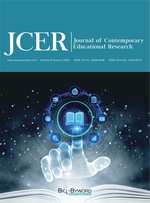Abstract
Language and culture are complementary, helpful, and inspiring to one another. Especially for foreign language learners, culture is extremely important to understand the social and cultural background of the target language. This study aims to explore foreign language learners’ perception towards cultural learning. In order to come to a conclusion, a quantitative method was adopted by distributing questionnaires to 31 Chinese EFL students. From the perspective of Chinese students, culture and cultural learning are crucial in the second language acquisition process.
References
Bardos J, 2004, Cultural Competence in Foreign Language Teaching. Studies in Language Pedagogy, 2004(20): 142-157.
Zhang H, 2007, Discussion on the Relationship Between Culture Learning and Foreign Language Learning. Language and Learning, 8(4): 14-18.
Ismail C, Birtan B, 2014, Foreign Language Learners’ Views on the Importance of Learning the Target Language Pronunciation. Journal of Language and Linguistic Studies, 10(1): 99-110.
McKay SL, 2000, Teaching English as An International Language: Implications for Cultural Materials in the Classroom. TESOL Journal, 9(4): 7-11.
Nault D, 2006, Going Global: Rethinking Culture Teaching in ELT Contexts. Language, Culture and Curriculum, 19(3): 314-328.
Saniei A, 2012, Proceedings of the 2012 International Conference on Language, Medias and Culture, March 10-11, 2012: Developing Cultural Awareness in Language Instructional Materials. ACSIT Press, Singapore, 10-15.
Bin Y, 2000, The Expression of Language Differences in the Context of Chinese and Western Cultures. China Academic Journal Electric Publishing House, 6(2): 27-32.
Tomlinson B, Masuhara H, 2004, Developing Cultural Awareness. Modern English Teacher, 13(1): 5-11.
Tomlinson B, 2000, A Multi-Dimensional Approach. The Language Teacher, 24(7): 1-6.
Byram M, 1997, Teaching and Assessing Intercultural Communicative Competence, Multilingual Matters, Bristol, England.
Kahraman A, 2016, Teachers and Learners Attitudes Towards Culture and Culture Learning in a Turkish Context. Journal of Language
and Linguistic Studies, 12(2): 1-12.
Simons GF, Fennig CD, 2018, Ethnologue: Languages of the World (21st Edition), SIL International, Dallas, TX.
Wang J, 2013, On the Results of Culture Learning in Foreign Language Education. Journal of Changchun Normal University (Humanities and Social Sciences), 11(1): 5-12.
Allison SR, Vining CB, 1999, Native American Culture and Language. Bilingual Review, 24: 193-207.
Hernandez CA, 2009, Language, Culture, Perception and Knowledge. McNair Scholars Journal, 13(1): 63-71.
Bjerke J, 2014, Learning to Acknowledge and Understand Other Cultures by Recognizing Your Own. Recruiter.com. https://www.recruiter.com/recruiting/learning-to-acknowledge-and-understand-other-cultures-by-recognizing-your-own/
Williams D, 2019, How Culture Is Important in Language Learning. TranslateMedia. https://www.translatemedia.com/translation-blog/culture-important-language-learning/
Sinicrope C, Norris J, Watanabe Y, 2012, Understanding and Assessing Intercultural Competence: A Summary of Theory, Research, and Practice. Second Language Studies, 26(1): 1-58.
Kahloei D, 2012, The Effect of a Positive Attitude Toward the Target Culture on Language Learning, University of Guila, Iran.
Kovacs G, 2017, Culture in Language Teaching: Course Design for Teacher Trainees. Acta Univ Sapientiae, Philologica, 9(3): 73-86.
Teo A, Kaewsakul W, 2016, Cultural Contents in Fundamental English Coursebooks. NIDA Journal of Language and Communication, 21(27): 1-17.
Hatoss A, 2004, A Model for Evaluating Textbooks as Mediators of Culture. Babel, 39(2): 25-32.
